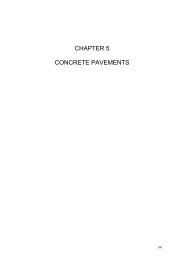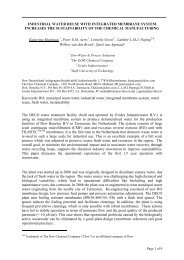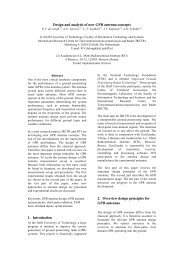Lecture Notes CT 4860 Structural Pavement Design Design of ...
Lecture Notes CT 4860 Structural Pavement Design Design of ...
Lecture Notes CT 4860 Structural Pavement Design Design of ...
You also want an ePaper? Increase the reach of your titles
YUMPU automatically turns print PDFs into web optimized ePapers that Google loves.
heq = 0.9 h1 (E1 / Em) 0.33 = 0.9 * 150 * (300 / 100) 0.33 = 194 mm<br />
We can now calculate the vertical stress using the same Boussinesq chart but this time the depth<br />
at which we have to determine the stress is 194 + 150 = 344 mm which is at a depth <strong>of</strong> z = 2.3<br />
a.<br />
From figure 27 we notice that now the vertical stress is equal to approximately 20% <strong>of</strong> p being<br />
140 kPa.<br />
5.3 Stresses in two layer systems<br />
If the stresses in the subgrade, the half space, due to the wheel load are too high, a stiff top is<br />
needed to reduce these stresses. Such a system, a stiffer layer on top <strong>of</strong> a s<strong>of</strong>ter half space, is<br />
called a two layer system. It could represent e.g. a full depth asphalt pavement on top <strong>of</strong> a sand<br />
subgrade.<br />
Burmister [5] was the first one who provided solutions for stresses in a two layer system. Again,<br />
it is beyond the scope <strong>of</strong> these lecture notes to provide a detailed discussions on the mathematical<br />
background. Here only attention will be paid to the results <strong>of</strong> those mathematical analyses<br />
and how they can be used in practice.<br />
Figure 31 shows the effect <strong>of</strong> a stiff top layer on the distribution <strong>of</strong> the vertical stresses in a two<br />
layer system. First <strong>of</strong> all we notice that the distribution <strong>of</strong> the vertical stress is bell shaped.<br />
Furthermore we notice that the magnitude <strong>of</strong> the vertical stress is quite influenced by the<br />
stiffness <strong>of</strong> the top layer. The width <strong>of</strong> the stress bell however is much less influenced by the<br />
stiffness <strong>of</strong> the top layer.<br />
Figure 31: Distribution <strong>of</strong> the vertical stress in a one and two layer system.<br />
A stiff top layer not only provides protection to the second layer, also tensile stresses at the<br />
bottom <strong>of</strong> the top layer develop. These stresses are due to bending <strong>of</strong> the top layer. This implies<br />
that for two layer systems we are dealing with two design parameters being the horizontal tensile<br />
32











